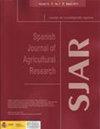Testing local isolates of entomopathogenic nematodes against the green stink bug Nezara viridula L.
IF 0.8
4区 农林科学
Q3 AGRICULTURE, MULTIDISCIPLINARY
引用次数: 0
Abstract
Aim of study: The green vegetable bug Nezara viridula L. is a polyphage that is spread all over the world, but in the last 10 years it has entered the territory of the Russian Federation. The use of biological protection against this pest is an important task in the country. We used the entomopathogenic nematodes (EPN) Steinernema feltiae and Steinernema carpocapsae to control N. viridula. Area of study: Federal Research Center of Biological Plant Protection (FRCBPP), Krasnodar Krai, Russia, 2019-2020. Material and methods: A laboratory test was carried out with adults and nymphs of N. viridula. Each species of EPN (S. carpocapsae and S. feltiae) was used at doses of 50, 75 and 100 individuals infective larvae per insect. The initial material for analysis was collected on soybean crops in the crop rotation of the FRCBPP. The experimental results were assessed using ANOVA. Main results: Laboratory tests of the EPN S. carpocapsae and S. feltiae caused the death of up to 98.0% of nymphs and up to 91.4% of adults of N. viridula. The species S. feltiae turned out to be the most effective, as allowed the pathogen to develop in shorter periods of time, and caused the death of 81.9-91.4% adults and of 92.0-98.0% nymphs. Research highlights: This study showed that during the period of growth and development of larvae, the use of EPN is more effective in nymphs than on adults.昆虫病原线虫对绿蝽Nezara viridula L。
研究目的:绿色蔬菜虫Nezara viridula L.是一种遍布世界各地的多噬菌体,但在过去的10年里,它进入了俄罗斯联邦的领土。利用生物防护手段防治这种害虫是我国的一项重要任务。采用昆虫病原线虫(EPN) feltiae斯坦纳马和carpocapsae斯坦纳马防治病毒乳杆菌。研究领域:俄罗斯克拉斯诺达尔边疆区联邦生物植物保护研究中心(FRCBPP), 2019-2020。材料与方法:用病毒乳杆菌成虫和若虫进行实验室试验。分别以每只昆虫50、75和100只感染幼虫为剂量,对每只昆虫使用EPN (carpocapae和feltiae)。用于分析的初始材料是在FRCBPP轮作中的大豆作物上收集的。采用方差分析对实验结果进行评价。主要结果:经实验室检测,豆荚棘球蚴(S. carpocapsae)和感觉棘球蚴(S. feltiae)的若虫死亡率高达98.0%,成虫死亡率高达91.4%。结果表明,在较短的时间内,S. feltiae是最有效的,导致81.9-91.4%的成虫和92.0-98.0%的若虫死亡。研究重点:本研究表明,在幼虫生长发育期间,EPN对若虫的使用效果优于对成虫。
本文章由计算机程序翻译,如有差异,请以英文原文为准。
求助全文
约1分钟内获得全文
求助全文
来源期刊

Spanish Journal of Agricultural Research
农林科学-农业综合
CiteScore
2.00
自引率
0.00%
发文量
60
审稿时长
6 months
期刊介绍:
The Spanish Journal of Agricultural Research (SJAR) is a quarterly international journal that accepts research articles, reviews and short communications of content related to agriculture. Research articles and short communications must report original work not previously published in any language and not under consideration for publication elsewhere.
The main aim of SJAR is to publish papers that report research findings on the following topics: agricultural economics; agricultural engineering; agricultural environment and ecology; animal breeding, genetics and reproduction; animal health and welfare; animal production; plant breeding, genetics and genetic resources; plant physiology; plant production (field and horticultural crops); plant protection; soil science; and water management.
 求助内容:
求助内容: 应助结果提醒方式:
应助结果提醒方式:


